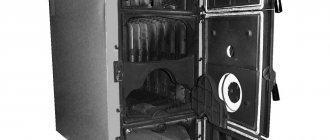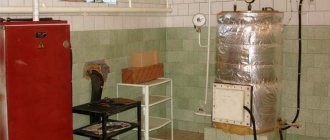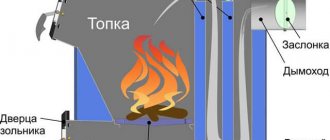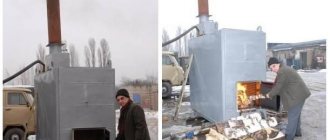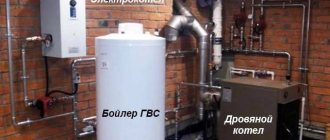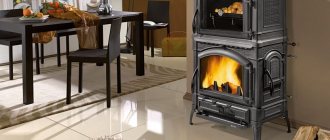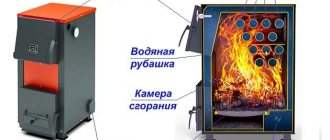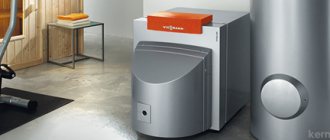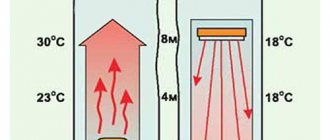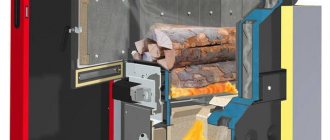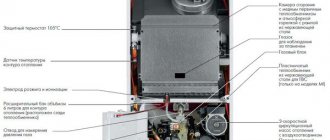Home / Solid fuel boilers
Back
Published: 05/14/2019
Reading time: 5 min
0
3131
Boiler manufacturers offer a wide range of boilers, differing in characteristics, purpose, type of fuel and quality. Industrial boilers can be gas, electric, solid fuel, gas-oil, combined, water-heating and steam.
Industrial solid fuel boilers are used by enterprises for heating and hot water supply needs. Such equipment is used in industrial, administrative, commercial, and agricultural buildings. Since such premises are usually large in area, they use powerful equipment that runs on solid fuel (pellets, briquettes, coal), with a power of 100 kW and above.
- 1 Pros and cons of industrial solid fuel boilers
- 2 Types of industrial solid fuel boilers 2.1 Steam boilers
- 2.2 Hot water
- 4.1 Requirements for TT boiler houses
Pros and cons of industrial solid fuel boilers
Industrial solid fuel water heating boilers are a good alternative to gas installations, especially when the gas main runs too far.
Most of these enterprises, having completed an economic calculation of the costs of design estimates, purchase and installation of gas equipment, confidently choose solid fuel boilers. Such thermal installations have both advantages and disadvantages.
The advantages include:
- autonomy;
- automatic control system;
- high heat output and efficiency (except for coal furnaces);
- variability in the choice of solid fuel;
- simple operation and maintenance;
- quick and easy installation of heating systems;
- combustion control system;
- availability of security systems.
However, it is worth highlighting the disadvantages:
- creating conditions for storing fuel reserves;
- more frequent equipment maintenance (cleaning of the firebox, chimney);
- regular monitoring of combustion processes and fuel supply;
- lack of a reliable temperature control system.
Advantages of industrial solid fuel models
Industrial hot water boilers using solid material as fuel are a good alternative to traditional gas equipment. Many enterprises, when calculating the costs of installing and servicing gas boilers, make a targeted choice in favor of solid fuel. This is especially beneficial for those who have access to cheap raw materials.
An industrial solid fuel unit has pros and cons. The advantages include:
- The main advantages of this type of boiler include autonomy.
- Possibility to save part of the funds when recycling production waste.
- Automatic control system.
- Possibility of using almost any solid fuel.
- High performance and efficiency.
- Unpretentiousness and ease of use and care.
- Possibility to create powerful heating complexes (up to 40 MW).
- Installation of equipment is carried out in a short time.
- Modern solid fuel units are equipped with a flame control complex.
- The safety protection built into the model reduces the entry of combustion products into the room to zero.
Types of industrial solid fuel boilers
Steam boilers
Boiler units producing saturated and superheated steam are necessary for heat supply, hot water supply and for the operation of steam engines.
The temperature of the saturated steam is 100ºC under a pressure of 100 kPa. The temperature of superheated steam reaches 500ºC with a pressure above 26 MPa. The purpose of these types of steam is different: saturated steam is used to supply heat to residential buildings, and superheated steam is used by industrial enterprises and in the energy complex. The operating principle of a steam boiler is to generate steam by heating water when burning fuel.
The scheme for heating water and generating steam is as follows:
- The prepared water is directed using a pump into a container in the boiler.
- Next, the water enters the collector.
- After the collector, the water rises again to the fuel combustion zone.
- Steam is generated in the pipes and rises upward.
- The steam follows further into the separator, where steam and water are separated, after which the steam passes into the steam line.
The structure of a steam boiler includes a tank where water is converted into steam, a furnace where fuel is burned, a chimney, water treatment and safety systems. Steam boilers are classified according to several characteristics.
Type of fuel:
- gas;
- coal;
- fuel oil;
- electric.
By purpose:
- household;
- industrial;
- energy;
- recycling.
By design:
- gas pipes;
- water tube
Hot water
Hot water boilers are used for heating and supplying hot water. Despite the main purpose of such boilers, recently they are increasingly used in industrial enterprises to meet technological needs, where a total heating output of more than several megawatts is not required.
The operation scheme of hot water boilers is direct-flow. It consists of sequential heat exchangers located in the combustion chamber and gas ducts. In previous decades, manufacturers produced boilers from cast iron, usually with a power of up to 1.7 MW and a coolant temperature of up to 115 ° C at a pressure of 0.4 MPa. The design of such boilers involved the assembly of cast iron sections, the number of which determined the heating capacity. Nowadays, mainly steel water-tube boilers are produced with a wide choice of power - from 30 kW to high-power boilers of 120 MW and water temperature up to 200 ° C at a pressure from 0.75 to 2.4 MPa.
Classification of solid fuel steam boilers
The varied design of solid fuel boilers provides many reasons for classification. Most often, the main parameters used are the method of loading fuel, the design of the boiler, which determines the combustion time of the fuel, the materials of the heat exchanger and the principle by which energy is transferred. (See also: Heating boilers)
Solid fuel steam boilers differ mainly in the method of heat exchange. Depending on this parameter, fire-tube and water-tube steam boilers are distinguished. The principle of their operation is as follows. Passing through the pipes of a water-tube boiler, the water is warmed by the heat generated by the fuel burning during operation. This is how water is converted into steam. Fire-tube steam boilers are distinguished by the fact that the above process in them occurs in the reverse order: in this case, water is on the outside of the pipes, and heat flows through them.
Depending on the method of fuel loading, boilers with manual and automatic fuel loading are distinguished. Boilers with manual fuel loading operate on coal, wood and briquettes, while automatic boilers operate on wood pellets.
Requirements for the premises for installing an industrial TT boiler
To install a solid fuel boiler, you must follow the requirements for the room where it is installed:
- Height. The room for a solid fuel boiler must have a ceiling height of 2.5 meters.
- The distance from the top of the boiler to the ceiling must be maintained at least 70 cm.
- For ease of loading fuel, it is necessary to maintain a distance from the front of the boiler to the opposite wall of no less than 2 meters.
- There must be a distance of at least 1 meter between the boiler and the side wall or adjacent boilers.
- The walls of the room must comply with fire resistance class EI45 (45 minutes) to avoid fire in other rooms if the boiler catches fire. The wall material is brick covered with plaster.
- Boiler room doors should preferably face the street; if this condition is not possible, then fire doors with fire resistance class EI30 (30 minutes) must be installed. Doors and windows must be sealed to prevent the spread of gases and smoke. The width of the doorway must be at least 800 mm - this is a condition for normal evacuation of people in the event of an accident and a necessity when moving equipment and fuel.
Advantages and disadvantages
Any device, no matter how high its quality, has not only positive qualities, but also negative ones.
Considering the features of a steam unit, the advantages worth highlighting are:
- It does not require a special boiler room
- Has minimal heating time
- Easy to use
- Costs 25% less than other boilers of similar power
- Economical during downtime
However, steam boilers that use solid fuel also have a number of disadvantages.
Among which we should highlight:
- During operation, it is necessary to strictly adhere to the correspondence between fuel consumption and the amount of steam produced. This disadvantage can be compensated for by using a two-stage operation scheme of a solid fuel unit.
- The equipment does not have accumulating water and steam volumes, which can be compensated for by a well-regulated fuel supply.
Based on these features of the equipment, we can say that it can be used only in the absence of strict requirements for the quality of steam and the need for its reserve stock.
Block boiler houses using solid fuel
A block boiler room is a small-sized modular room in which the process of burning fuel and heating water in heat exchangers takes place to meet the needs of heating and hot water. Sometimes for the construction of a boiler house it is necessary to use several such blocks, each of which performs the functions provided for by the project. Each object requires an individual calculation of a block-modular boiler room.
The scope of application of such solid fuel boiler houses is very wide. They are used for heating industrial, administrative, commercial, and agricultural facilities with an area of up to 10 thousand sq.m.
The advantage of using a block-modular boiler house is high autonomy, efficiency, high efficiency, unpretentiousness in operation, low installation costs, and the ability to transport the boiler house to another facility.
BMK are quite easy to operate and do not require constant monitoring by maintenance personnel. Fuel supply is carried out automatically. The design provides for the installation of fire protection equipment and sensors that ensure high reliability.
Requirements for TT boiler houses
The dimensions of the boiler room must satisfy the condition of free access to all parts of the equipment, since the operation of boiler equipment requires regular inspections and inspections.
Based on this, the minimum area of the boiler room is calculated:
- for equipment with a total power of up to 30 kW - at least 3 sq.m.;
- for equipment with a total power from 30 kW to 60 kW - at least 5.5 sq.m.;
- for equipment with a total power of 60 kW - at least 6 sq.m.;
- The height of the boiler room from floor to ceiling must be at least 2.5 m.
The design of the boiler room and the materials of walls, windows and doors must ensure tightness and fire resistance for at least 45 minutes. To fulfill this requirement, the walls of the boiler room are covered with fire-resistant plaster with a layer of at least 3 mm. A steel sheet with a thickness of 0.8 mm or more is laid under the boilers. These requirements are the same for any equipment of any brand. And even with the best solid fuel boilers with reliable protection and high-quality manufacturing, compliance with the equipment conditions of the boiler room is mandatory.
Construction of a solid fuel steam boiler
Today, steam boilers of different steam outputs are available for sale. The upper and lower drums are located on a vertical plane, one above the other. They are united by a network of convective bundle pipes, which, in turn, are secured by rolling in drums. The installation of the convection bundle pipes is carried out at a distance of about 90 mm from each other along the drum itself. The width of the lateral sinuses should be 195-387 mm. (See also: Which boiler to choose?)
The combustion chamber includes dense side screens, as well as side rows of convection bundle pipes, which are connected along the entire length to the lower collectors. The upper ends of the pipes are connected to the upper drum. To produce the rear as well as the front wall of the combustion chamber, a special refractory brick is used. A window is made on the right side of the combustion chamber wall, and in the future it is through it that the combustion products will enter the afterburning chamber. The lower part of the afterburning chamber is inclined towards the firebox. This is done in order to make it easier for pieces of burnt fuel to fall onto the grill.
